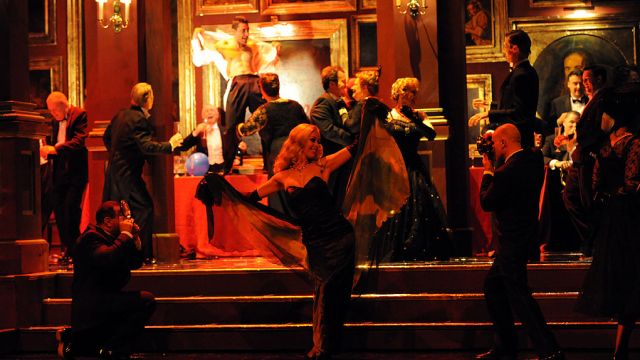Rigoletto
As certain a crowd-puller as anything in Opera Australia’s repertoire, Elijah Moshinsky’s 1991 take on Verdi’s powerful melodrama returns for more spins of its marvellous revolving set. Though almost 20 years old, the production’s 1950s Fellini-inspired design still seems a great idea. The dissolute Duke of Mantua’s opening party comes hot from La Dolce Vita, with drunk/drugged couples twisting the night away, cardinals dancing with circus girls, and toffs betting on races with fashionable lady jockeys riding puffing, crawling aristocrats. Amazingly, Verdi’s 1851 music fits just fine.
Not that court jesters were around much in the 1950s. This Rigoletto (Alan Opie) is a mordant hunchback, hobbling around on two walking sticks. He doesn’t even try to amuse anyone, let alone his boss, the Duke (Paul O’Neill), who scolds that “you always push a joke too far”. Rigoletto’s brand of jesting relies on dark mockery: he’s the Les Patterson of his day. Everyone hates him, except his daughter Gilda (Emma Matthews) who begs him to let her leave the house, to go anywhere other than to daily Mass.
There’s a great sense of creative fun in this interpretation, from the lusty two-dozen-strong male chorus in dark glasses, to the motor car — a tiny ‘Italian Job’ mini — into and out of which poor Rigoletto must several times cram and extract himself. The heightened reality keeps melodrama at bay until, unable to hold back the Act 3 floods, director Moshinsky lets rip with added thunder, lightning and electrical fuse-blowing. Verdi goes for broke, too, of course, and the opera ends in magnificent desolation. The thunderous applause lasted many minutes.
Alan Opie has a busy night as the hated outsider and loving father. His rich baritone dominates the many set-piece duets and brilliant Act 2 quartet: he keeps returning to his feelings of cursed doom. Emma Matthews, as the innocent, preyed-upon girl in this deadly misogynistic society, thrills with some tremendous vocal flourishes. Almost to the end, dressed as a man and illogically determined to save her rotten lover, she defies the innate absurdity. “Am I ready to die so young?” she sings. Oh, yes, indeedy. (The OA program states that her performance is ‘proudly sponsored by Jennifer Brukner’: thanks, Jennifer.)
Paul O’Neill’s sleek, sex-mad Duke seemed under-par at this performance, and his top notes kept the audience uneasy. Before the start of Act 3 an on-stage announcer told us that Paul was suffering a flu bug but had agreed to gamely soldier on. This got a huge round of applause and, naturally, everything he did thereafter was loudly appreciated, especially his brave rendition of Verdi’s mighty ‘La donne e mobile’, the great hit song of its day.
The gorgeous set is almost worth the price of admission. It offers Moshinsky an almost cinematic sweep in the first act and a real grounding in backstreet reality for the more static acts that follow. Fellini would have loved it.
Frank Hatherley
Photo: Opera Australia's Rigoletto. Photographer: Branco Gaica
Subscribe to our E-Newsletter, buy our latest print edition or find a Performing Arts book at Book Nook.

